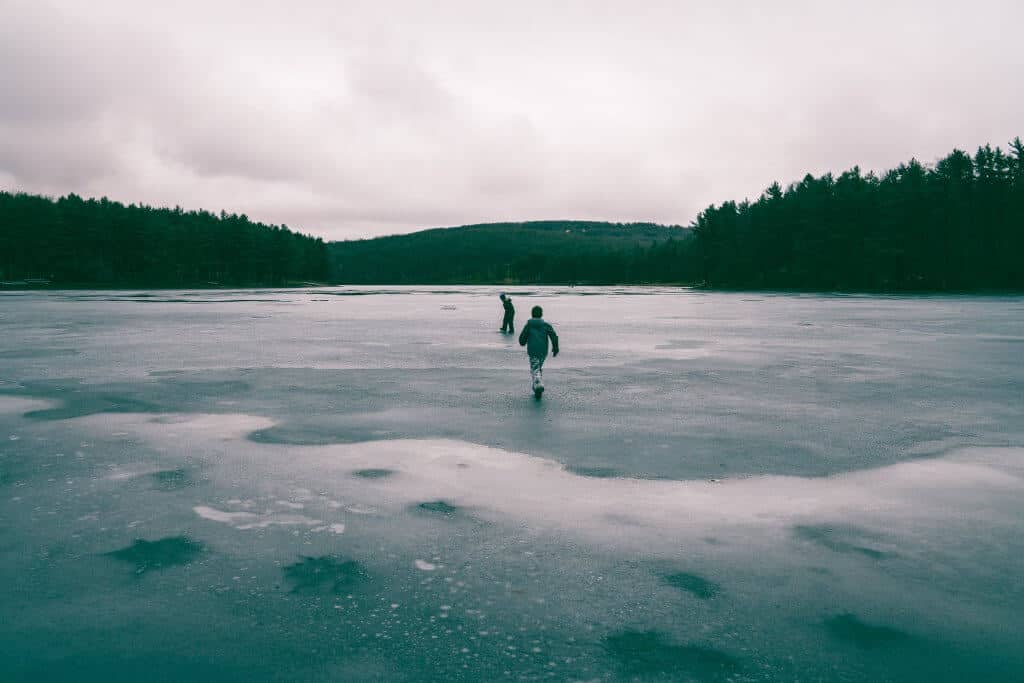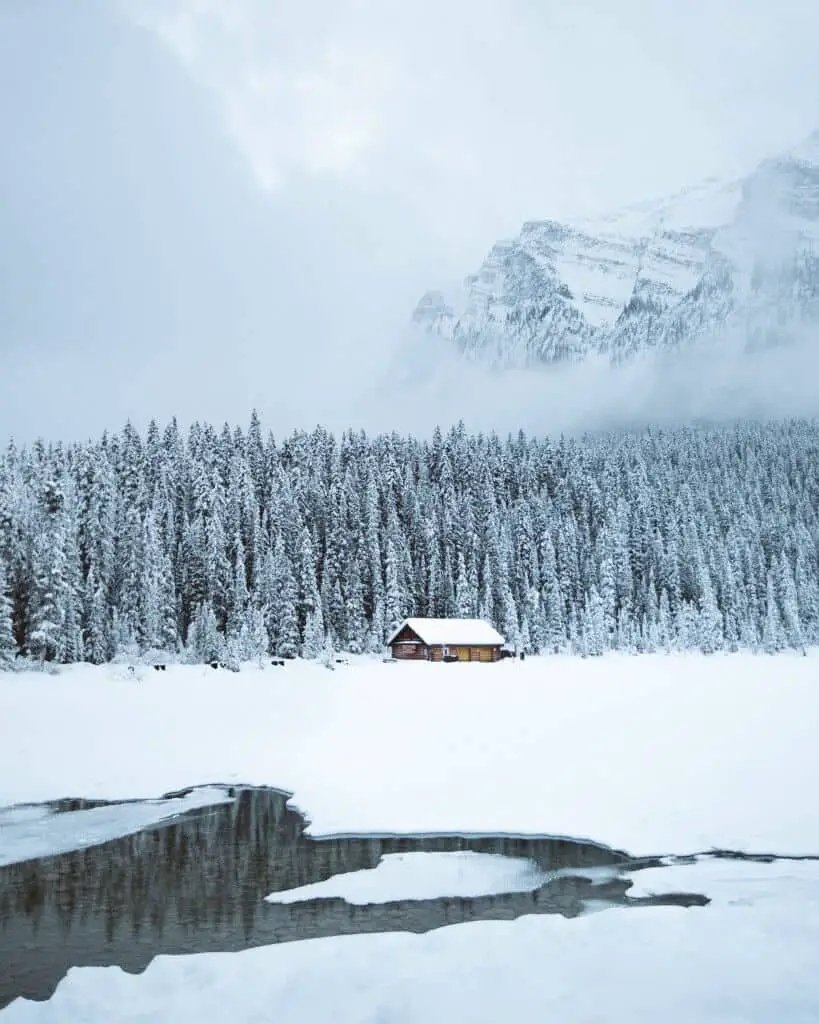Ice fishing is an amazing sport, which many people want to enjoy as early and for as long as possible. However, it may not be safe to step on the ice fully or head out to the middle of the frozen lake, especially if you are going early or late in the season. If you do step on the lake and there is cracking it is time to get off of that lake immediately.
Accidents do happen and there can be some circumstances where a person may fall into a frozen lake.

What to Avoid to Not Fall in a Frozen Lake
Here are some steps to follow to prevent a person from falling in a frozen lake and if they do how to care for them:
Be Aware of the Thickness & Integrity of the Ice
You should always be aware of the thickness of the ice when you are thinking about going ice fishing, skating or doing other activities on a frozen lake. It is imperative to always know the thickness of the ice.
You can check the thickness by using an ice chisel also called spud bar or even a tape measure and should prepare by checking any reports on the ice conditions on the internet or, depending where you live, it might also be in the local paper.
If the ice is less than 2 inches thick stay off it at all cost, as the ice will not be able to support body weight. If the ice is around 4 inches thick it is okay for ice fishing. If the ice is 12 inches thick or more it is safe to drive on. If you have any doubts about the thickness or do not feel that the ice is right stay off of it. Better safe than sorry.
If the temperatures have been above freezing for a couple of days be very careful before stepping on the ice or doing other activities on it. Watch out for any bubbles having formed within the ice as these are a sign of deteriorating integrity of the ice. This counts doubly so, if you are thinking about setting up an ice fishing shelter or any other structure.
Wear and Take Quality Gear
First, you should go for a floatable ice suit. If you have a great one, you are extremely likely not to drown plus the insulation and waterproof features help shielding you from the extreme cold. Second, bring an ice pick.
With the help of it, you can get a grip on the ice much better than without. Third, you should also always carry rope with you, which can allow you to help someone else out, i.e. if you are going fishing in at least a pair, which is highly recommended. We are expanding on this later in this post.
Do Not Step on the Ice to Help
If someone does fall in a frozen lake the person they are with may be tempted to run after them and grab them. Do not do this! You will risk falling through as well and this will create additional problems. If the person in the water is unconscious or if they cannot stay above the water and someone needs to approach them there is a safer way to do this.
Approaching the hole in the ice should be the absolute last resort, but in these cases it might be necessary. Instead of running or walking towards the hole, you should crawl out to where the person is to reduce your impact on the ice and minimize the chance of falling through by distributing your weight on the surface.
What to Do If Someone Fell in a Frozen Lake
Okay great, but some dude still managed to fall in. What can I do?
Call for Help
The best thing you can do if you are with someone that has fallen into the ice is to call emergency services. They have trained rescuers that will complete the ice rescue safely.
Unless you absolutely need to approach them immediately to keep them from dying, the first thing you should do is to call immediately. If you panic or try to help the person before calling for help you are losing valuable time.
Remain Calm
This may be the most difficult thing to do but it is one of the most important. While waiting for rescue to arrive it is essential to remain calm. It is also important to help the victim calm down. Tell the person help is on the way and let them know as long as they can stay above the water they will be saved in time.
They may go into cold shock for up to three minutes of being in the water. They need to control their breathing to prevent hyperventilating. Speak to them about keeping movement up while focussing on breathing.
Coach Them to Escape
If they do remain calm, there is a possibility that a person can get themselves out of the water. The person that is with them can help coach them. They should go to the edge of the ice and use their elbows to try to lift themselves out of the water. They should focus on getting a grip on the edge of the ice.
If they try to pull themselves out in another manner, the weight of their wet clothing plus the bodyweight is going to be too much for the ice. If they happen to have sharp objects such as keys or even an ice pick with them, it can help them get a grip on the ice.
The victim should kick their legs horizontally. If they do manage to get out, they should roll away from the hole to reduce the impact of their weight on the ice.

Helping Them Out
Just to reiterate: Do not go out on the ice to help the victim out. While waiting for rescue, if you do have rope with you or if there is a solid treebranch in the immediate vicinity, you can hand or throw that out to the person, who ideally would be able to pull themselves out.
If you are using a rope, it is helpful to tie a bowline knot to the end of the rope. This way the victim can put their arm through the role as they are being assisted out of the icy water. When pulling them out, stay at a safe distance to avoid weak ice.
Aftercare
Once the person is out of the water and if they have no pulse begin CPR until help arrives. Icy water can lower the body temperature and slow down the functions of the body. If they do not appear to be breathing they still might be alive.
Emergency services can help instruct you to do CPR via phone if you have not done this before and they will also try to calm you down. Make use of this!
Get Them Warm
It is important to help this person get warm. Take off their wet clothing and wrap them up in blankets or whichever clothing you have available. Try to get them lukewarm water, as anything too hot can be dangerous.
Focus on restoring heat to the trunk area first. Get them off the cold ground. Finally, get them to a hospital as fast as possible.
Happy (and Safe) Ice Fishing!
These are some steps to take to assist a person that has fallen into a frozen lake or ideally avoid falling into it in the first place. While walking on ice should be avoided when in doubt and especially when temperatures have been unstable, accidents do happen. If you are planning on drilling holes soon, make sure that someone else will be able to come with. Never fish alone!
Also consider getting ice cleats to avoid slipping and potentially injuring yourself. You should always stay as calm as possible and follow this advice to help your friends stay alive after falling through the ice. Finally, check out the iceshanty forum for discussions on ice fishing safety and read about 8 great ice fishing lakes in Maine!
Disclaimer
The information presented on this website represent the opinions of the authors. By using the information, you acknowledge that there are potential hazards which may cause damage to you and or others. You agree to hold harmless Fishstainable.com from any liability resulting from your use of the information.
Neither Fishstainable.com, its sponsors and advertisers, or any of the individual authors accept any liability for the consequences of using the materials, products or services presented on these pages. Use the information on this website at your own risk!